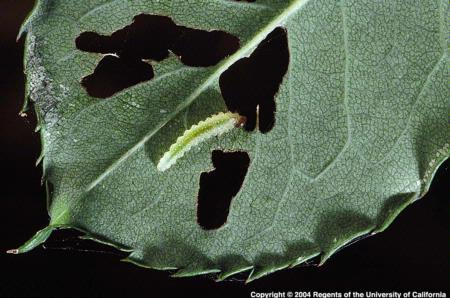
Rose Slugs
By Leslie E. Stevens UCCE Master Gardener
What's turning my rose leaves into skeletons? Kathy M. San Luis Obispo
Those raggedy, semi-transparent leaves ruining the appearance of your rose bushes are likely evidence of bristly rose slugs – the black-to-pale-green larvae of the sawfly. The younger caterpillar-like larvae skeletonize the leaf undersides, while more mature larvae finish the job by chewing large holes in the leaves.
Starting in spring, watch for the appearance of shiny black adult sawflies. These stingless wasps are so named for the female's saw-toothed egg-laying appendage. She uses these to make cuts along rose leaf edges, inserting a single egg in each pocket. Sawflies produce up to six generations annually, with the last one overwintering as pupae in the soil.
The damage rose slugs cause is not only unsightly, but the pests' leaf feeding strips the green chlorophyll from the foliage, diminishing the rose's ability to photosynthesize and potentially weakening the plant. Manage small infestations by pruning out infected leaves and picking off and killing the pests. You also can try hosing off rose slugs with a strong blast of water. Just remember to use the hose method in the early morning to allow foliage to dry before nightfall. Lingering wet foliage can introduce fungal infections such as mildew and rust.
If needed, treat heavy rose slug infestations by spraying an insecticidal soap or spinosad, making sure to coat both sides of leaves. Insecticidal soaps kill only the rose slugs it comes in direct contact with while spinosad must be injested by the insect. Therefore, it may be necessary to do subsequent applications throughout the warm growing season as long as the pests are present.
It is important to avoid using broad-spectrum insecticides to control sawflies and rose slugs, since they also indiscriminately kill the many beneficial predators such as parasitic wasps and predaceous beetles that help control the pests.
By regularly inspecting your rose bushes for pests and diseases and eliminating any problems early, you'll likely enjoy many months of healthy plants and beautiful, fragrant blooms.